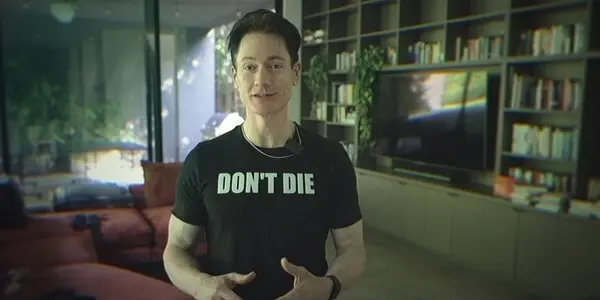Reviewed by Jeffrey Sanzel
Netflix is streaming Don’t Die: The Man Who Wants to Live Forever, focusing on Bryan Johnson, the entrepreneur who is “determine[d] to live forever—or die trying.” Johnson, now forty-seven, believes death’s inevitability should not be accepted and embarked on an extreme anti-aging protocol.
Johnson founded and was CEO of Braintree, a company specializing in web payments for e-commerce. In 2012, Braintree acquired Venom for over $26 million. One year later, PayPal (then part of eBay) bought the company for $800 million; estimates put Johnson’s profit at $300 million. In October 2021, Johnson announced Project Blueprint, his anti-aging endeavor. Don’t Die focuses on this mission, turning his life into a longevity experiment.
The much-lauded director Chris Smith (Jim & Andy: The Great Beyond, Fyre, 100 Foot Wave, etc.) created a documentary alternating between Johnson’s daily regimen and his more extreme activities. Each morning, Johnson exercises for an hour, takes a massive number of medications and supplements, eats several pounds of vegetables (he is vegan), and undertakes a range of therapies (light therapy, a hair growth cap, and others). He has a medical-grade clinical operation in his home worth $2.5 million.
Every vital sign is measured and tracked. At the time of the filming, he was in the optimal 99th percentile for both muscle and fat. He claims to have reversed his biological age by 5.1 years in two years. His speed of aging is .69, which means that he ages eight months every twelve months.
In addition to the more commonplace, Johnson ventured into the world of plasma exchange with his son, Talmadge (as well as giving his own to his father), organ transplant medication suppressing the immune system, and gene replacement therapy (performed on the island of Roatán, off the coast of Honduras).
Much of the film displays his relationship with his son, Talmadge, who came to live with him for his senior year of high school. The divorced Johnson became estranged from his ex-wife and three children when he left the Mormon church. Talmadge, struggling with his own beliefs, chose to join Johnson, who quickly brought him into his world of exercise, diet, and some of the more extreme endeavors. The uncomfortable scenes between them feel forced. Whether they share genuine affection is hard to parse with the mostly unexpressive Johnson.
While shopping with Talmadge for towels in a Chicago Target, Johnson breaks down at the thought of his son entering the University of Chicago. Is he crying for his son or the cameras? Even Johnson’s statement, “I wish I had Talmadge’s legs. He’s the perfect specimen,” resonates less complimentary and more disturbing.
Johnson claims relationships are important but admits he is not good at them. (Don’t Die briefly mentions the ugly lawsuit surrounding his breakup with Taryn Southern following her breast cancer diagnosis.)
Don’t Die’s tone varies, alternating between pedestrian day-in-the-life and darker moments that suggest an episode of Black Mirror. In its most extreme, the film offers shades of Jurassic Park and, in one particularly uncomfortable sequence about surgical experiments with mice, The Human Centipede.
For over half the film, Johnson is shirtless in his kitchen, swallowing pills or eating the same meal (2,000 calories a day of the same food). He works closely with Kate Tolo, his Chief Marketing Officer, who seems a combination of companion and majordomo. While his initial online presence was not huge, an article by Ashlee Vance (who co-produced Don’t Die) turned Johnson into a viral sensation, generating both positive interest and hate. In this shift, Johnson rose as an almost cult figure.
People bought many products Johnson consumes with direct links from his website to Amazon. Eventually, he produced and promoted Brian Johnson’s Blueprint Extra Virgin Olive Oil, resulting in accusations of Johnson as a grifter. The undertaking led to “Don’t Die” events, including hikes and dances. Held around the world, Johnson has gathered many followers.
The talking heads range from medical professionals (doctors, scientists, etc.), some of whom support the work, and others who see it as a waste of money and resources. These contrast with social media pundits, the majority of whom are pointedly negative. Vance’s strong presence alternates between marveling at Johnson’s audacity and questioning his actions. Johnson’s parents are prominently featured but add little insight into who he really is.
At just under an hour and a half, the film seems overlong and repetitive. The unending stream of medium shots and generic footage of weightlifting, pill-taking, and laboratory visits would be more engaging if only Johnson possessed a modicum of charisma. But something is lacking at his core. Even his comments about the greater good can be reduced to a bizarre trickle-down theory.
Perhaps his entire gestalt is summed up with his bold but problematic statement: “Our minds, which we think are our primary tool of problem-solving, are actually the source of self-destructive behaviors. I would argue the mind is dead.”
At best, Don’t Die documents one man’s quest for immortality. At worst, it is a portrait of the power of excessive narcissism fueled by vast wealth. Or, as one scientist states: “It’s not science. It’s just attention.”







